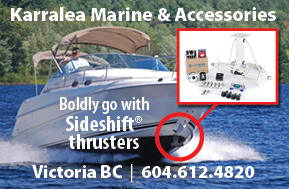Go further to get closer — get closer to what matters most to you in Desolation Sound
Desolation Sound is a tiny region but we highlight it because it offers an experience beyond civilization, within the sheltered, warm waters of the Salish Sea. Desolation Sound Marine Park is considered by many boaters to be the one of the top cruising grounds in the world. The waters of Desolation Sound are calm and sheltered with lots of protected anchorages, and plentiful oysters, clams, crabs, prawns and salmon. The park consists of more than 14,000 acres of land and 6,350 acres of shoreline and water. There are four lakes and a waterfall in Desolation Sound Marine Park.
You are most likely getting here via the Sunshine Coast. Your provisioning points are Powell River or Lund. Explorers of the Discovery Islands (to the west and north) often include Desolation Sound. Desolation Sound is often the crowning stop on a circle tour of the Salish Sea. While in the Sound, your handiest supply point is Refuge Cove with fuel, basic supplies including liquor, not to mention quintessential BC coastal character. Its located on the southwest tip of West Redonda Island, about 6-10 NM from the Park.
Warm summer temperatures and the meeting of the tides create mild climate, warm water and rich sea life.
Surprisingly, the warmest salt water north of Mexico (27°C/82°F) awaits swimmers in Pendrell Sound. Travel Hint: Warm waters make Desolation Sound an ideal May or September destination. That is when you can have the sound of whales blowing, the taste of freshly caught fish and crab and the sight of foraging bears all to yourself.
Prideaux Haven (50 8.8 N 124 41.1 W) As the name suggests, it is tranquil in this incredibly beautiful, well-protected maze of islets, coves, inlets, and passages. In the summer, Prideaux Haven is one of the most popular anchorages on the B.C. coast, with warm salt water swimming and socializing among friendly vacationers. There are scores of good anchorages in the Haven and in nearby Melanie Cove and Laura Cove, which are often less inhabited. What were once orchards offer an opportunity to stretch legs or have a shore picnic near both Coves. This is fabulous kayaking water amid islands and the lagoon on the south side of Copplestone Island.
Tenedos Bay (50 6.8 N 124 42.3 W) This bay is surrounded by Desolation Sound Marine Park. It is more than 300 feet deep in the central area, but there are lots of coves and nooks shallow enough for small craft. The most protected anchorages are at the north end of the bay, but the eastern area is usually the busiest, with a short trail onshore leading to Unwin Lake — an idyllic, secluded swimming area. Fresh water is available here. Mt. Spooner dominates the eastern view.
Okeover Arm This inlet offers a marina in Penrose Bay as well as Okeover Resort, Okeover Provincial Park, and a public float on its western shore. The trip up Okeover Inlet is as scenic as the waters of Desolation Sound, and less crowded. Lancelot Inlet is usually sparsely populated with boats and offers wide mountain vistas and a few secure anchorages. Keep exploring and get further away from others in Theodosia Inlet, entered through a narrow passage from Lancelot Inlet. There are several good anchorages. One place you do not want to miss is Okeover Landing. The little provincial park by that name has a short trail accessed from beside the Harbour Authority. The reason most make this trip is to dine at The Laughing Oyster. Power is available here, but there is no water and no garbage dump. The Harbour Authority has room for a few transients. Much of Okeover Arm is leased as oyster beds.
Grace Harbour Coming in via Malaspina Inlet, Grace Harbour is near the SE corner of Gifford Peninsula. There are several anchorages here, and lots of areas to explore. The inner harbour is completely protected and the shore offers trails and old logging roads for hiking — including a path on the north side of the top of the Harbour to a fresh water lake for swimming. Boaters can beach dinghies on the island in the entrance and check out a park information board showing the surroundings.
Other favourite anchorages in the Desolation Sound area include Pendrell Sound, Roscoe Bay and Teakerne Arm on the Redonda Islands, while Mansons Landing and Squirrel Cove on Cortes Island are also wonderful places to stop — for more information on these areas see the Discovery Islands section.
Fishing BC
Explore a British Columbia that few people without a boat have seen. Surround yourself with majestic scenery, abundant wildlife and plenty of fishing opportunities. To the east of Campbell River and just north of Desolation Sound you’ll find a large network of tidal channels and inlets that are home to both resident and migrating salmon. Go mooching in deep inlets or find a spot in a tidal rip to catch a passing Chinook, and don’t forget to drop a prawn trap on the way.









